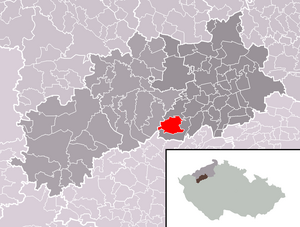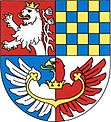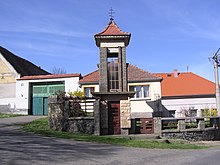Pnětluky
| Pnětluky | ||||
|---|---|---|---|---|
|
||||
| Basic data | ||||
| State : |
|
|||
| Region : | Ústecký kraj | |||
| District : | Louny | |||
| Area : | 1474.7913 ha | |||
| Geographic location : | 50 ° 15 ′ N , 13 ° 42 ′ E | |||
| Height: | 335 m nm | |||
| Residents : | 339 (Jan 1, 2019) | |||
| Postal code : | 440 01 | |||
| License plate : | U | |||
| traffic | ||||
| Street: | Milostín - Louny | |||
| structure | ||||
| Status: | local community | |||
| Districts: | 2 | |||
| administration | ||||
| Mayor : | Ladislav Andrt (as of 2013) | |||
| Address: | Pnětluky 26 440 01 Louny 1 |
|||
| Municipality number: | 566578 | |||
| Website : | www.pnetluky.cz | |||
| Location of Pnětluky in the Louny district | ||||

|
||||
Pnětluky , until 1923 Netluky (German Netluk ) is a municipality in the Czech Republic . It is located 14 kilometers southwest of Louny and belongs to the Okres Louny .
geography
Pnětluky is located in the Džbán Mountains in the valley of the Pnětlucký brook. The village lies in the area of the Džbán Nature Park. The Okrouhlík (444 m) and the Červený vrch (400 m) rise to the northeast, the Podhora (459 m) to the east, the Pravda (484 m) southeast, the Zadní Rovina (524 m) to the south, and the Pískový vrch (southwest). 526 m) and the Špičák (490 m) and in the west of the Výrov (509 m).
Neighboring towns are Markvarec in the north, Hřivice , Babylon and Konětopy in the Northeast, Solopysky, Horni Ročov and Dolní Ročov the east, Pochvalov and Domoušice the southeast, Brůdek, Chanov, Perun, Džbán and Mutějovice in the south, Na Rovinách, Kounov , Janov and Deštnice in the south-west, Nečemice, Nový Dvůr, Výhledy, Kozlov, Nový Svět and Lhota in the west and Třeskonice, Nový Dvůr and Tuchořice in the north-west.
history
The first written mention of the village took place in 1250 in a document of the Olomouc deanery, in which the son of the Elbogen burgrave Zvěsta von Pnětluky, Sulislav, appeared as a witness. Their ancestral seat was probably near the village of Záhoří, which died out during the Hussite Wars. The oldest news about the Church of St. Matthew comes from 1363. The Lords of Pnětluky built a manor house next to the church , which was first mentioned in writing in 1377. The lords of Pnětluky held the property for the most part until the beginning of the 15th century, and part of the village was acquired by the lords of Žirotín. There are records of pastors in Pnětluky until 1414. In the 1430s, Beneš von Kolowrat became the owner of Pnětluky, but in 1437 the brothers Mikuláš and Vilém von Jankov contested the property. The dispute was finally settled by dividing the village, with the lords of Kolowrat buying up the share of the Jankov brothers a little later and uniting Pnětluky with their lords Ročov and Pravda. With the construction of Pravda Castle by the lords of Kolowrat, the Pnětluky fortress lost its importance as a manor house, it was left to decay and in 1456 was called desolate . The cultivation of hops has been documented since the 15th century. In 1523 the lords of Kolowrat sold the combined lordship of Ročov and Pravda to Diepold von Lobkowicz . He had a new fortress built in place of the desolate manor. The goods Pnětluky and Lipenec were separated from Ročov and Pravda under the lords of Lobkowicz and united to an allodial rule . Later both goods fell to other sexes. In 1602 Johann Prollhofer von Burgersdorf sold the Pnětluky estate to Wolf the Elder. Ä. from Vřesovice, who added it to his rule Nowyhrad .
After the Battle of the White Mountain , the rulership was confiscated and in 1623 sold by the Court Chamber to the Electoral Saxon Sergeant General Wolf Ilburg von Wresowitz. He sold it to Johann von Aldringen in 1630 . According to his will, Nowyhrad fell to the Strahov Premonstratensian Monastery after the death of the military leader near Landshut in 1634 . In 1647 Pnětluky was sacked and devastated by Swedish troops. However, the Strahov Monastery, impoverished by the Thirty Years' War, was unable to make the payments associated with the donation of 10,000 each to the Viennese Dominicans and three monasteries in the Duchy of Luxembourg and had the rule judged and auctioned. In 1651 a buyer was found in Margrave Christian Wilhelm von Brandenburg . At that time Pnětluky consisted of eight farms and 15 Chalupner inns , eleven of which were desolate. In the berní rula from 1654, six farmed properties are listed for Pnětluky including the former Premonstratensian court, the rest of the place was described as burned down and abandoned. The parish went out again and the church was ruined. After the death of Margrave Christian Wilhelm in 1665 his underage cousin, Margrave Friedrich inherited the rule. His father, Elector Friedrich Wilhelm , sold the reign of Neuschloß to Gustav Adolph von Varrensbach in 1670 . In 1688 his widow Marie Sidonie, nee Countess Schlick , inherited the property. The next owner was her daughter Maria Claudia Countess von Praß in 1697, who sold the estate to Anna Barbara von Lewenegg, née von Tondeur, in 1715. The first mention of a school comes from the year 1715. In 1762 Anna von Lewenegg's son Leopold Graf von Lewenegg became the owner of the estate. His widow Maria Josepha, née Countess von Eschevenia, sold the reign of Neuschloß on March 31, 1767 to Joseph I. zu Schwarzenberg for the primogeniture of the Schwarzenberg family . Subsequent owners were from 1782 his son Johann I , from 1789 his son Joseph II and from 1833 Johann Adolf II zu Schwarzenberg .
In 1844 Netluk / Netluky consisted of 50 houses with 346 Czech-speaking residents. In the place there was the branch church of St. Matthew, in which there was a church service every third Sunday, as well as a school, an official farm with sheep, an inn and a mill. The parish was Opochna . Until the middle of the 19th century Netluk remained subject to the allodial rule of Neuschloß .
After the abolition of patrimonial formed Netluky / Netluk 1850 a municipality in the county and judicial district Laun. The volunteer fire brigade was founded in 1878 . In 1900 Netluky had the highest population in its history with 636 inhabitants. The Hop Growing Association was established in 1909. In 1924 Pnětluky was introduced as a Czech place name. Until 1924 the manor was owned by the Schwarzenbergs . In 1937 there were 98 hop farmers in the village. During the last days of the Second World War, an artillery division of the Vlasov Army was stationed in Pnětluky in April 1945 . Konětopy was incorporated in 1961. On January 1, 1980, Pnětluky and Konětopy came as districts to Hřivice , since November 24, 1990, both villages have formed the municipality of Pnětluky.
Community structure
The municipality Pnětluky consists of the districts Konětopy ( Konotop ) and Pnětluky ( Netluk ). The municipality is divided into the cadastral districts Konětopy u Pnětluk and Pnětluky . Pnětluky also includes the layers Brůdek ( Brudek ) and Chánov ( Chanow ).
Attractions
- former fortress Pnětluky of the lords of Lobkowicz from the 16th century, it was converted into a baroque granary in the 18th century
- Church of St. Matthäus, the late baroque building was built in 1765 under Leopold von Löwenegg, where the old church, which can be traced back to 1363 and burned down in the Thirty Years' War, is not known. The organ was created at the beginning of the 20th century and is the work of the Rieger organ builder from Jägerndorf
- Crucifix on the church, created in 1830
- Bell tower of the Czechoslovak Hussite Church , the modernist building from 1940 is the work of Václav Zralý
- Memorial to those who fell in World War I, unveiled in 1924
- Horse chestnut at the extinguishing water pond, tree monument
- Pravda castle ruins from the middle of the 15th century, southeast of the village on the ridge of the same name
- Natural monument Kozinecká stráň , northwest of Pnětluky
- Čertův kámen ( Devil's Stone ) rock , east above the village on the Pravda
- Stone faces from Úvoz, in the forest above the village. The masks and caricatures carved into the sandstone rock were created during the First Republic during a holiday camp for students from the Hořice School of Sculpture
- Domoušice or Rovina castle on the plaque of the same name southwest of Pnětluky. From the late Hallstatt fortifications from the period between 560 and 460 BC. Remains of the wall and the moat have been preserved. On the Rovina there are also the Kounov stone rows .
Sons and daughters of the church
- František Schneider (1862–1918), the teacher from Laun, gained fame as a hop growing expert and worked as director of the Bohemian Hop Association and editor-in-chief of the Chmelařské listy ( Hop Leaves ). At the Paris World Exhibition in 1900 , Schneider was the organizer of the Bohemian Hops Exhibition, which was awarded a gold medal.
- Václav Zralý (1906–1991), architect. The Bauhaus graduate became a member of the architectural group Levé fronty ( Left Front ) in Czechoslovakia , but their style was not very well received. Zralý took part in several architectural competitions, but only one villa was realized in Prague-Košíře. During the Great Depression he left Prague, earned his living in Paris as a worker and then returned to Pnětluky, where, according to his plans, the villas No. 114 and 116, the bell tower of the Czechoslovak Hussite Church and agricultural buildings were built. He also built several buildings in Louny. Zralý was also the designer of the hop drying plant, which was built not far from the church in 1955, and which has a lasting impact on the townscape.
Web links
Individual evidence
- ↑ Obec Pnětluky: Podrobné informace. Retrieved October 15, 2013 (Czech).
- ↑ Český statistický úřad - The population of the Czech municipalities as of January 1, 2019 (PDF; 7.4 MiB)
- ↑ Johann Gottfried Sommer The Kingdom of Bohemia, Vol. 14 Saatzer Kreis, 1846, p. 38
- ↑ Části obcí: Obec Pnětluky. Retrieved October 15, 2013 (Czech).
- ↑ Katastrální území: Obec Pnětluky Retrieved October 15, 2013 (Czech).





